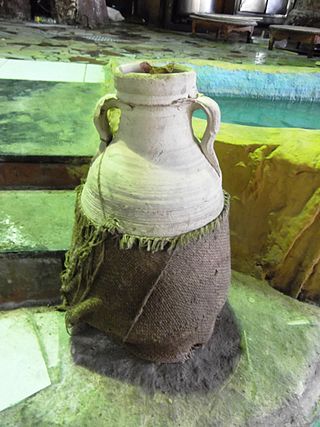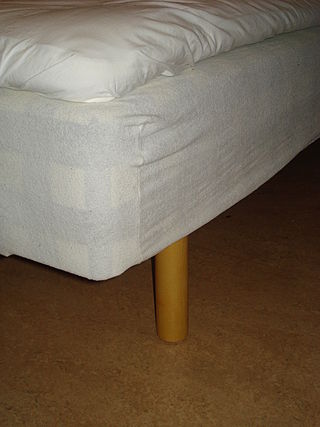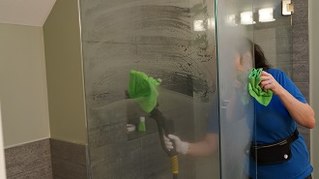
A vacuum cleaner, also known simply as a vacuum, is a device that uses suction in order to remove dirt from floors, upholstery, draperies, and other surfaces. It is generally electrically driven.

Cleaning is the process of removing unwanted substances, such as dirt, infectious agents, and other impurities, from an object or environment. Cleaning is often performed for aesthetic, hygienic, functional, safety, or environmental protection purposes. Cleaning occurs in many different contexts, and uses many different methods. Several occupations are devoted to cleaning.

A clothes dryer, also known as tumble dryer or simply dryer, is a powered household appliance that is used to remove moisture from a load of clothing, bedding and other textiles, usually after they are washed in a washing machine.

Microfiber is synthetic fiber finer than one denier or decitex/thread, having a diameter of less than ten micrometers.

An evaporative cooler is a device that cools air through the evaporation of water. Evaporative cooling differs from other air conditioning systems, which use vapor-compression or absorption refrigeration cycles. Evaporative cooling exploits the fact that water will absorb a relatively large amount of heat in order to evaporate. The temperature of dry air can be dropped significantly through the phase transition of liquid water to water vapor (evaporation). This can cool air using much less energy than refrigeration. In extremely dry climates, evaporative cooling of air has the added benefit of conditioning the air with more moisture for the comfort of building occupants.

Superheated steam is steam at a temperature higher than its vaporization point at the absolute pressure where the temperature is measured.

A mop is a mass or bundle of coarse strings or yarn, etc., or a piece of cloth, sponge or other absorbent material, attached to a pole or stick. It is used to soak up liquid, for cleaning floors and other surfaces, to mop up dust, or for other cleaning purposes.
Housekeeping is the management and routine support activities of running and maintaining an organized physical institution occupied or used by people, like a house, ship, hospital or factory, such as cleaning, tidying/organizing, cooking, shopping, and bill payment. These tasks may be performed by members of the household, or by persons hired for the purpose. This is a more broad role than a cleaner, who is focused only on the cleaning aspect. The term is also used to refer to the money allocated for such use. By extension, it may also refer to an office or a corporation, as well as the maintenance of computer storage systems.

Swiffer is an American brand of cleaning products that is made by Procter & Gamble. Introduced in 1999, the brand uses the "razor-and-blades" business model, whereby the consumer purchases the handle assembly at a low price, but must continue to purchase replacement refills and pads over the lifespan of the product. Swiffer has become a half-billion dollar brand in fifteen countries.

Carpet cleaning is performed to remove stains, dirt, and allergens from carpets. Common methods include hot water extraction, dry-cleaning, and vacuuming.

Hot Water Extraction (HWE) is a method of carpet cleaning. It involves a combination of hot water and cleaning agents being injected into the fibers of a carpet at high pressure and the lifted soil being removed by a powerful vacuum.

A mattress protector is an item of removable bedding that sits on top of, or encases, a mattress to protect it. Some mattress protectors also provide protection to the person sleeping on the mattress from allergens and irritants such as dust mites, bed bugs, mold, and dead skin.

A cleaner or a cleaning operative is a type of industrial or domestic worker who does the cleaning.

Floor cleaning is a major occupation throughout the world. The main job of most cleaners is to clean floors.

Steam cleaning involves using steam for cleaning. Its uses include domestic applications in cleaning flooring and household dirt removal, and industrial uses in removing grease and dirt from engines.

Steam is a substance containing water in the gas phase, and sometimes also an aerosol of liquid water droplets, or air. This may occur due to evaporation or due to boiling, where heat is applied until water reaches the enthalpy of vaporization. Steam that is saturated or superheated is invisible; however, wet steam, a visible mist or aerosol of water droplets, is often referred to as "steam".
A truckmount carpet cleaner is a carpet and upholstery cleaning unit that is generally mounted to the floor of a van or trailer. Its cleaning method is hot water extraction. The operator would park the van near the premises, connect the vacuum hose and solution line hose into the machine, bring the hoses into the building, and connect a carpet cleaning wand to the end of the hoses.

A floor scrubber is a floor cleaning device. It can be a simple tool such as a floor mop or floor brush, or in the form of a walk-behind or a ride-on machine to clean larger areas by injecting water with cleaning solution, scrubbing, and lifting the residue off the floor. With advancements in robotics, autonomous floor-scrubbing robots are available as well.

Malting is the process of steeping, germinating and drying grain to convert it into malt. Germination and sprouting involve a number of enzymes to produce the changes from seed to seedling and the malt producer stops this stage of the process when the required enzymes are optimal. Among other things, the enzymes convert starch to sugars such as maltose, maltotriose and maltodextrines, hence the name malt.

















